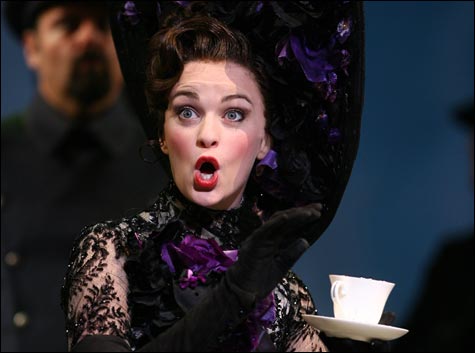
MY FAIR LADY: Lisa O’Hare would seem to be dogging Julie Andrews’s footsteps, but she resembles Audrey Hepburn in her gamine grit and grace. |
George Bernard Shaw, when asked whom he’d like to write the music for Pygmalion, replied “Mozart.” The composer of Don Giovanni having passed to the other side, GBS couldn’t have done much better than Alan Jay Lerner and Frederick Loewe, whose 1956 My Fair Lady gracefully opened up the 1914 fable its author proudly dubbed “didactic” while remaining true to its socialist heart. The 2001 National Theatre of Great Britain/Cameron Mackintosh production, a handsome restaging of which is on view at the Opera House (through February 17), further sharpens the Shavian edge of this beloved musical, placing it in a grand swirl of the class-entrenched Edwardian era coming to an end. Director Trevor Nunn has in fact moved the story of tyrannical phonetician Henry Higgins and the cockney flower girl he hopes to whittle into a duchess back just a few years to 1910, when Edward VII went the way of Mozart.
British classical-theater directors seem to have an affinity for American musicals. Despite being one of the parties responsible for Cats, former Royal Shakespeare Company and National Theatre honcho Nunn has staged much-lauded revivals of Oklahoma! and South Pacific as well as this elegant My Fair Lady with its deep bows to the British music hall and a landscape that encompasses not just the muck of Covent Garden and the street where Eliza Doolittle lives but the London Underground and a passel of suffragettes. The production design by Anthony Ward takes the high, arched architecture of Covent Garden and makes it do for Higgins’s book-shelved fortress of a library and, with its supports lit up like strips of footlights, the Embassy ball where the made-over Eliza, an erect and glittering swan, makes her Cinderella entrance into society. Speaking of Tchaikovsky’s favorite water bird: the choreography is by multiple Olivier and Tony Award winner Matthew Bourne, who crosses “With a Little Bit of Luck” with Stomp and “Ascot Gavotte” with Equus. The big dance numbers are rife with jigging, prancing, and social satire, but don’t look for furry-muscled male swans gliding up the Thames.

This production has been heralded as a reinvention, which it’s not, and that’s a good thing. After all, you begin with the advantage that My Fair Lady is one of the best and brainiest musicals there is. Shaw’s pointed tale of the guttersnipe transformed by genteel speech and deportment into the outward, deracinated embodiment of a lady is irresistible in both its elocutionary process and its poignant demonstration that (as GBS would have it) the true difference between a flower seller and a grande dame is not in her behavior but in how she is treated. Then you throw in the luxurious score, which runs the gamut from the swoony “I Could Have Danced All Night” and “On the Street Where You Live” to Higgins’s splenetic, Rex Harrison–inspired talk songs to the chirp of “Wouldn’t It Be Loverly?”, the ebullient tango of “The Rain in Spain,” and the life-force friskiness of “Get Me to the Church on Time” — this last rendered here as a wild ride of a bachelor’s debauch that takes Alfred P. Doolittle and his cockney cohort from the barroom to a girlie show to the street, the undulating groom-to-be ultimately as liquid as the hooch inside him.
The touring cast is mostly American, but its stars, Lisa O’Hare as Eliza and Christopher Cazenove as Higgins, are from across the Pond (though West End vet Cazenove is touted in the publicity for his 1980s TV turn on Dynasty). O’Hare, who moved into the lead in Mary Poppins in London, would seem to be dogging Julie Andrews’s footsteps, but she resembles Audrey Hepburn in her gamine grit and grace. Her posture is impeccable (even when the witty hat she wears to Ascot makes her look like a thing out of Mummenschanz), and her voice, though not large, is pretty (and mercifully undistorted by the sound system). Cazenove, though more stolid and less dapper than Rex Harrision, certainly echoes the originator of his presumptuous, dyspeptic role — a roaring boy of a bachelor who never gets closer to romantic capitulation than to admit he’s grown accustomed to his feisty protégée’s face. Marni Nixon, who dubbed Hepburn’s songs in the film, is a wry, empathetic Mrs. Higgins. As dense patrician pup Freddy Eynsford-Hill, Justin Bohon sings gloriously, even when clinging to a street lamp. And as that boldly amoral representative of the “undeserving poor,” Alfred P. Doolittle, Tim Jerome is so irrepressible — as is his lower-class posse — that you wonder whether Higgins didn’t have the right idea about what to do for this lot. Arrange for them to get some money, but don’t require that they cultivate the clenched jaw and the stick up the ass.